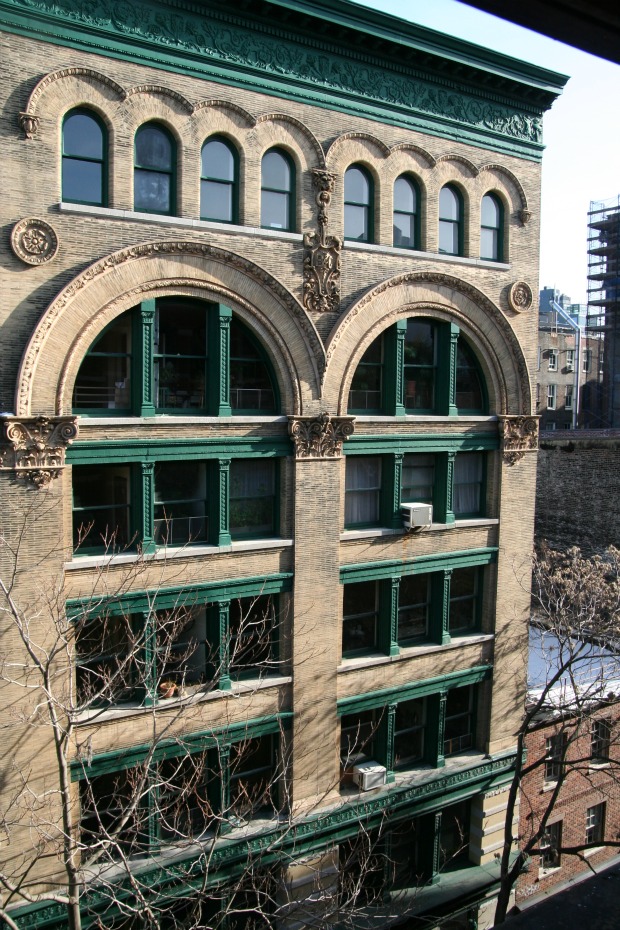Before models strolled down sidewalks studded with designer fashion boutiques in Soho, struggling artists rented studio and residential space for cheap south of Houston St. "Illegal Living: 80 Wooster Street and the Evolution of Soho," a new book by architect Shael Shapiro and journalist Roslyn Bernstein, charts the changes to the neighborhood through one building: 80 Wooster Street. On Wednesday, the authors read from their book at McNally Jackson Books at 52 Prince Street in Soho.
80 Wooster (which actually had the address of 80-82 Wooster) was a vacant industrial building back in the summer of 1967 when FluxHouse Cooperative II, run by artist George Maciunas, first acquired it with the help of a $20,000 grant from the J.M. Kaplan Fund and the National Foundation for the Arts. The 30,000 square-foot building was the first of 16 artist cooperatives that made up the FluxHouse Building Cooperative, a collective that encompassed the abandoned buildings Maciunas helped convert into artist studios.
"It was a real mess," said Shapiro, who was able to write "Illegal Living: 80 Wooster Street and the Evolution of Soho" from personal experience. He was a shareholder of a 2,500 square-foot space on the third floor of 80 Wooster -- for which he paid $5,000 -- soon after it was purchased by FluxHouse. "There was nothing in it and it was filled with debris."
In the '60s, city zoning law barred people from using industrial spaces as residences. But Shapiro said zoning code didn't make Maciunas think twice about bringing in artists to live there illegally.
"He was the one who believed artists should control their own destiny," Shapiro said. "Without him, Soho may have happened anyway. But he was the person who seized on it."
According to Shapiro, Maciunas envisioned a utopian neighborhood where creative ideas flowed between artists, composers and designers. He didn't restrict his tenant search to just Fluxus artists, but sought out anyone interested in living at the Soho artist co-ops.
In 1974, the so-called godfather of American avant-garde film, Jonas Mekas, moved the Filmmaker's Cinematheque he founded (which later became the Anthology Film Archives) onto the ground floor of 80 Wooster. Legions of other artists showed or performed their work in the building, including Andy Warhol, Nam June Paik, Allen Ginsberg, Yoko Ono and John Lennon. Phillip Glass gave his first performance in the space after returning from a trip to India. Playwright Richard Foreman performed plays in the space and artist Trisha Brown danced there. Jazz shows and improv theater performances were frequent.
But despite all of the art happenings going on at 80 Wooster, most of the residents spent more time dealing with the difficulties of living in converted factories — broken elevators, faulty plumbing and pesky rodents — than they did collaborating on art.
"Maciunas' vision never came through," Shapiro said. "The collectives just helped the building function."
Although the city had changed its zoning laws to permit residency in lofts in 1971, by the mid-'70's, real estate prices had risen in Soho. By the mid-'80's, boutiques had moved into the neighborhood. Artists began to get priced out and left the neighborhood. In 1979, artist happenings ceased in the building, and today, Christopher Fischer Cashmere, a clothing store, is the tenant at 80 Wooster Street.
"That's just life," said Shapiro. "When we moved here, we caused change."
He and Bernstein will read from their book on Wednesday at 7 P.M. Admission is free. Scroll down to see a photo of what 80 Wooster looks like today. (Photo by Amy McNulty)
